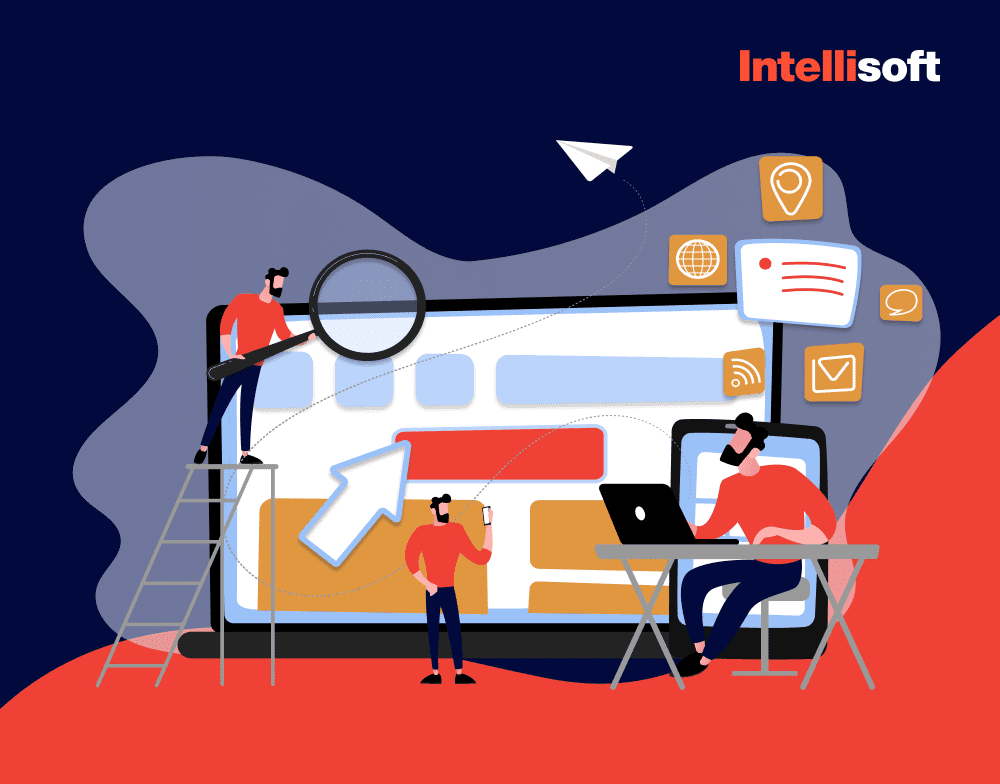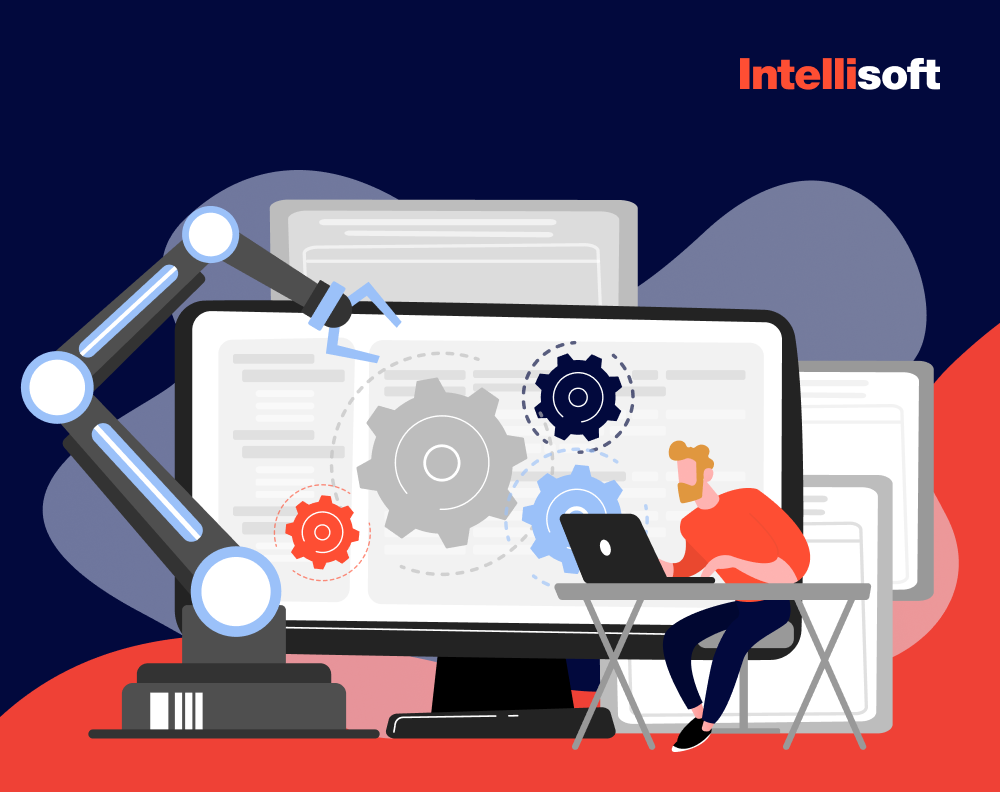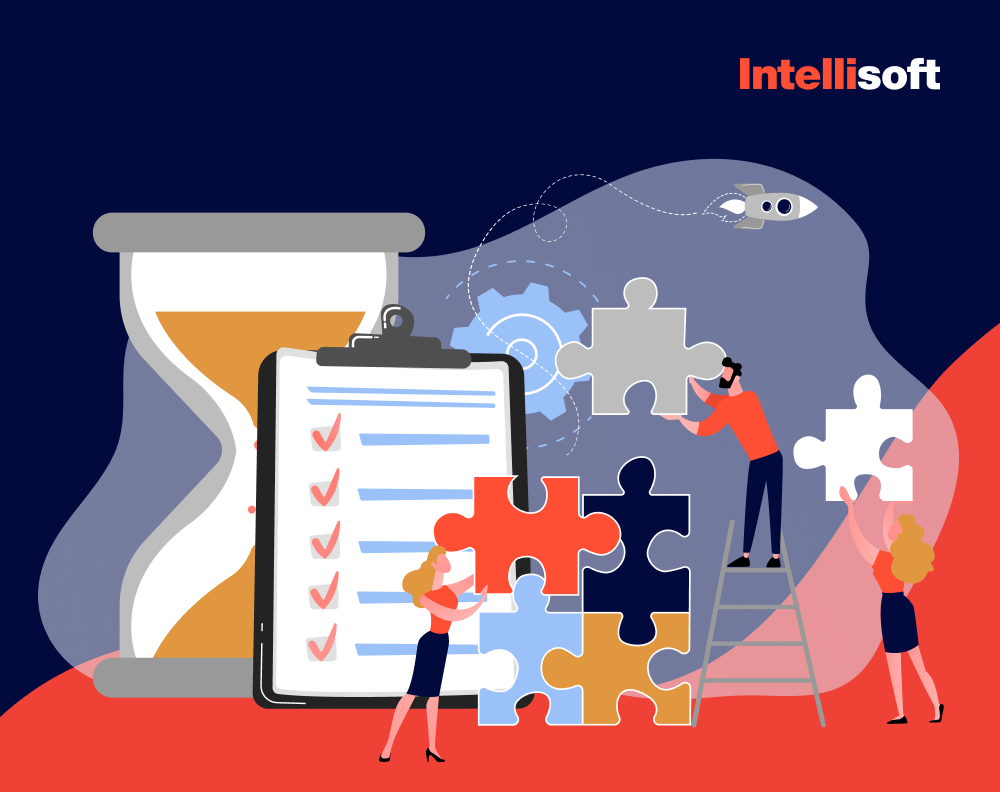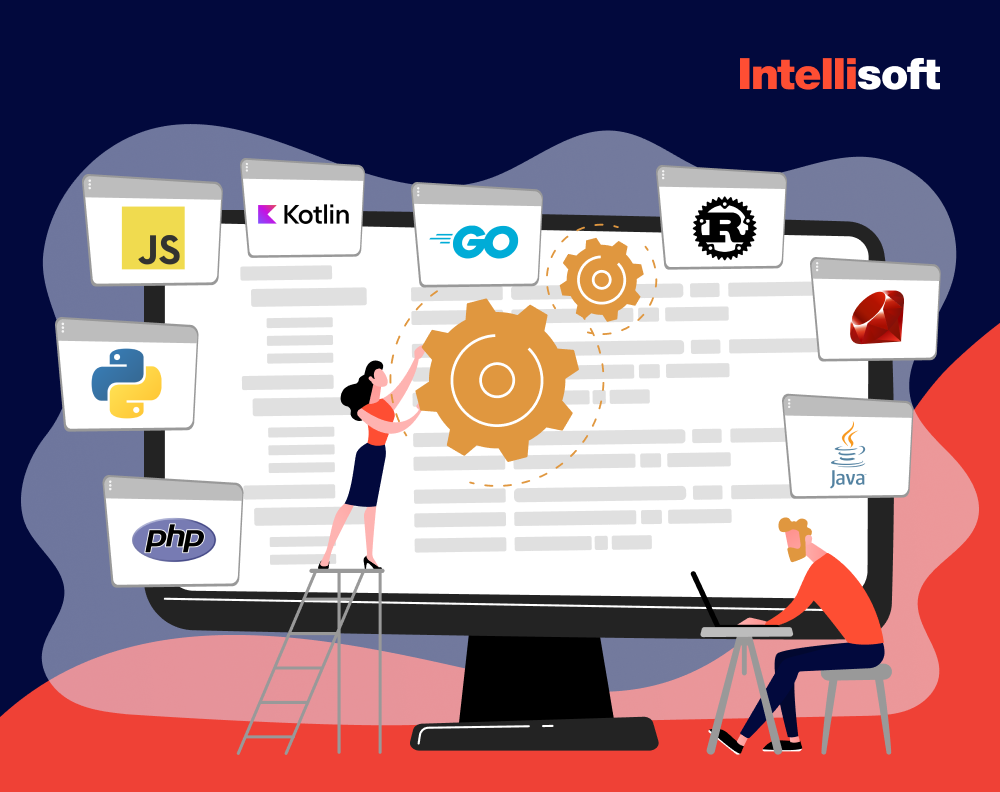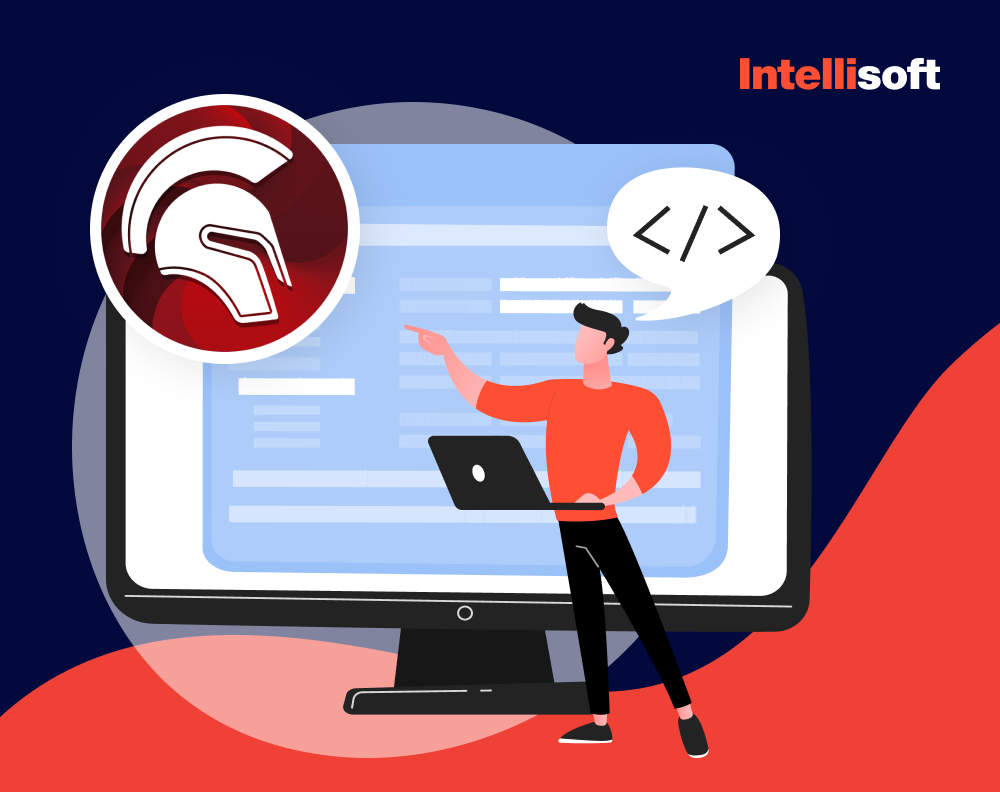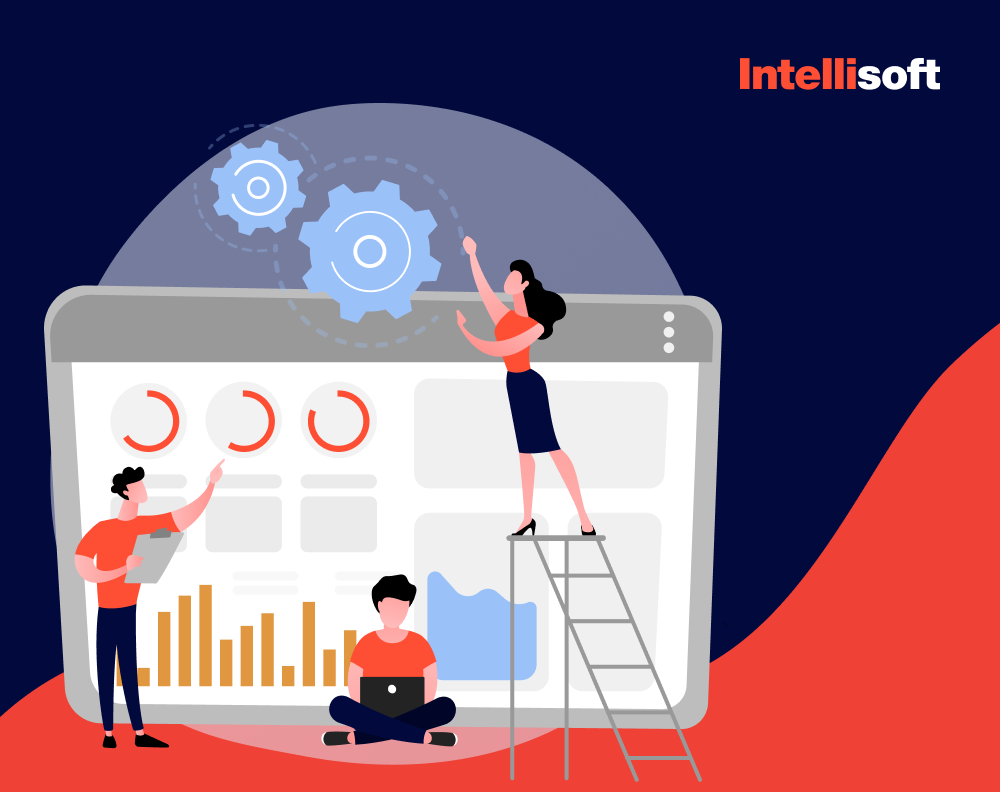The Food & Beverage industry is undergoing a massive transformation, and restaurant management software is quickly becoming a must-have. The restaurant management systems market was valued at $4.08 billion in 2021, and it’s expected to grow by 15.8% annually through 2030.
A recent State of Restaurant Tech report revealed that 75% of restaurant owners plan to invest in management apps in 2023 to increase efficiency and tackle rising food and labor costs.
In this article, we’ll explore the different types of applications, examine the critical steps in developing software for restaurant management, and provide insights by IntelliSoft team.
But first, let’s define what is restaurant management software and explain why it’s crucial for streamlining and improving day-to-day operations.
As Danny Meyer, Restaurateur and CEO of Union Square Hospitality Group, said, “Technology in restaurants isn’t just about adopting new tools; it’s about creating a more seamless and enjoyable experience for both staff and customers.”
Table of Contents
A Closer Look at Restaurant Management Software
A restaurant management system (RMS) is a tool designed to simplify the daily operations of any dining establishment, from cafés and diners to fast-food outlets and upscale eateries. Automating critical tasks helps owners and managers streamline their work, improve customer experiences, and boost overall business performance.
RMS technology enhances efficiency, reduces errors, and ultimately increases profits. Depending on the provider and the restaurant’s specific needs, these systems offer a variety of features that make running a food and beverage business smoother.
For instance, an RMS can help manage reservations, assign tables, prevent overbooking, and ensure every inch of the restaurant is used effectively. Other features might include scheduling shifts, restaurant labor management software, and handling payroll and tip distribution. It can also manage bookings from multiple channels—online or by phone—and keep waitlists organized, ensuring quick table turnover and shorter wait times for customers.
Restaurant staff can access easy-to-read dashboards filled with analytics that provide insights into different aspects of the business. This data is invaluable for making informed decisions and fine-tuning operations.
With a clear understanding of what a restaurant management system can do, let’s explore some key features that make these tools essential for modern eateries. But first, let’s examine the benefits they bring.
Uncovering the Pros of a Restaurant Management System
It’s widely known that adopting digital restaurant management solutions can give your business a competitive edge. Here’s a breakdown of the main benefits they offer:
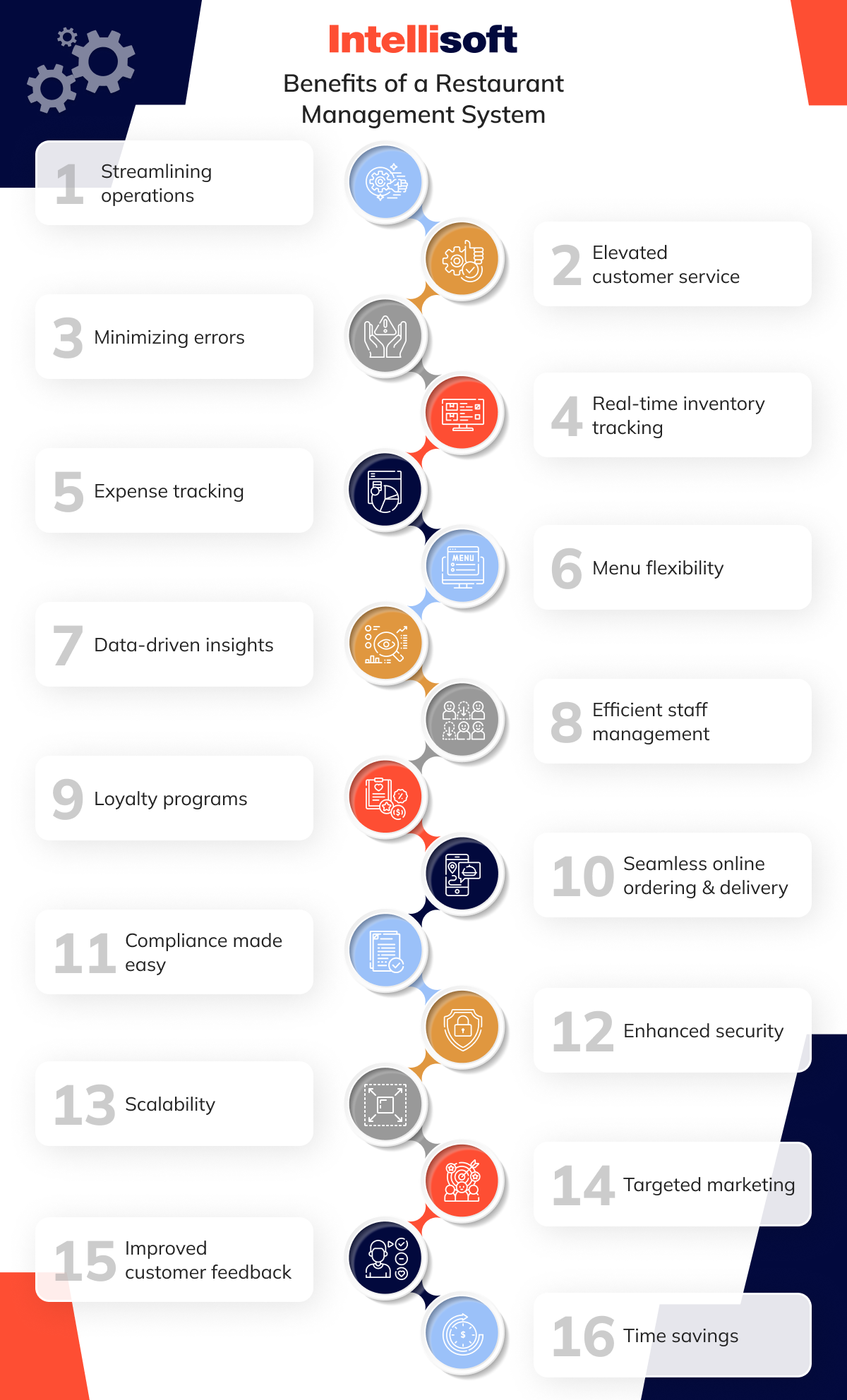
Streamlining operations
These systems (such as restaurant reservation management software) help facilitate key aspects such as order management, inventory control, and table reservations, making everyday operations more smoothly.
Elevated customer service
By effectively managing table bookings and waitlists, you can enhance the guest experience, reduce wait times, and ensure smooth operation.
Minimizing errors
With integrated restaurant order management software, you can significantly reduce mistakes and ensure customers get the right orders and accurate bills every time.
Real-time inventory tracking
The built-in inventory management database makes it easy to track stock in real-time, reducing food waste and ensuring the right inventory levels. This approach ultimately saves money and prevents unnecessary losses.
Expense tracking
You can closely monitor all your costs, from labor to ingredients and overheads, allowing for tighter cost control and more efficient budgeting.
Menu flexibility
Updating your menu is a breeze—whether you’re adding seasonal specials or phasing out certain dishes. This method keeps your offerings dynamic and appealing to guests.
Data-driven insights
Sophisticated reporting tools give insights into sales trends, customer preferences, and other critical data. These analytics lay the groundwork for more thoughtful and strategic decisions.
Efficient staff management
Restaurant management software also makes it easier to manage staff—handling schedules, tracking hours, and simplifying payroll, which helps reduce the burden on HR.
Loyalty programs
Many of these platforms offer features for creating and managing loyalty programs, which are great for encouraging repeat business and building a loyal customer base.
Seamless online ordering & delivery
Modern solutions integrate effortlessly with online ordering and restaurant delivery management software, simplifying the process from kitchen to customer.
Compliance made easy
They also help ensure you align with health, safety, and tax regulations. Automating these processes reduces the risk of costly compliance issues.
Enhanced security
Robust security features protect customer data and payment details, reducing the risk of breaches and ensuring safe transactions.
Scalability
As your restaurant grows, these solutions can grow with you, handling more orders, tables, and a larger staff without missing a beat.
Targeted marketing
With access to customer data, you can run targeted promotions and marketing campaigns, helping to boost engagement and drive sales.
Improved customer feedback
These systems make collecting and analyzing feedback easy, so you can address any issues and continuously improve customer satisfaction.
Time savings
By using restaurant task management software, you free up your staff to focus on delivering great service and enhancing other aspects of the business.
Solutions for Running a Restaurant: A Comprehensive Overview
Running a restaurant requires more than great food—it also requires the right tools to keep things running smoothly. From managing orders to tracking inventory, restaurant software management ensures everything goes smoothly.
Here are some key types of software that help restaurants thrive:
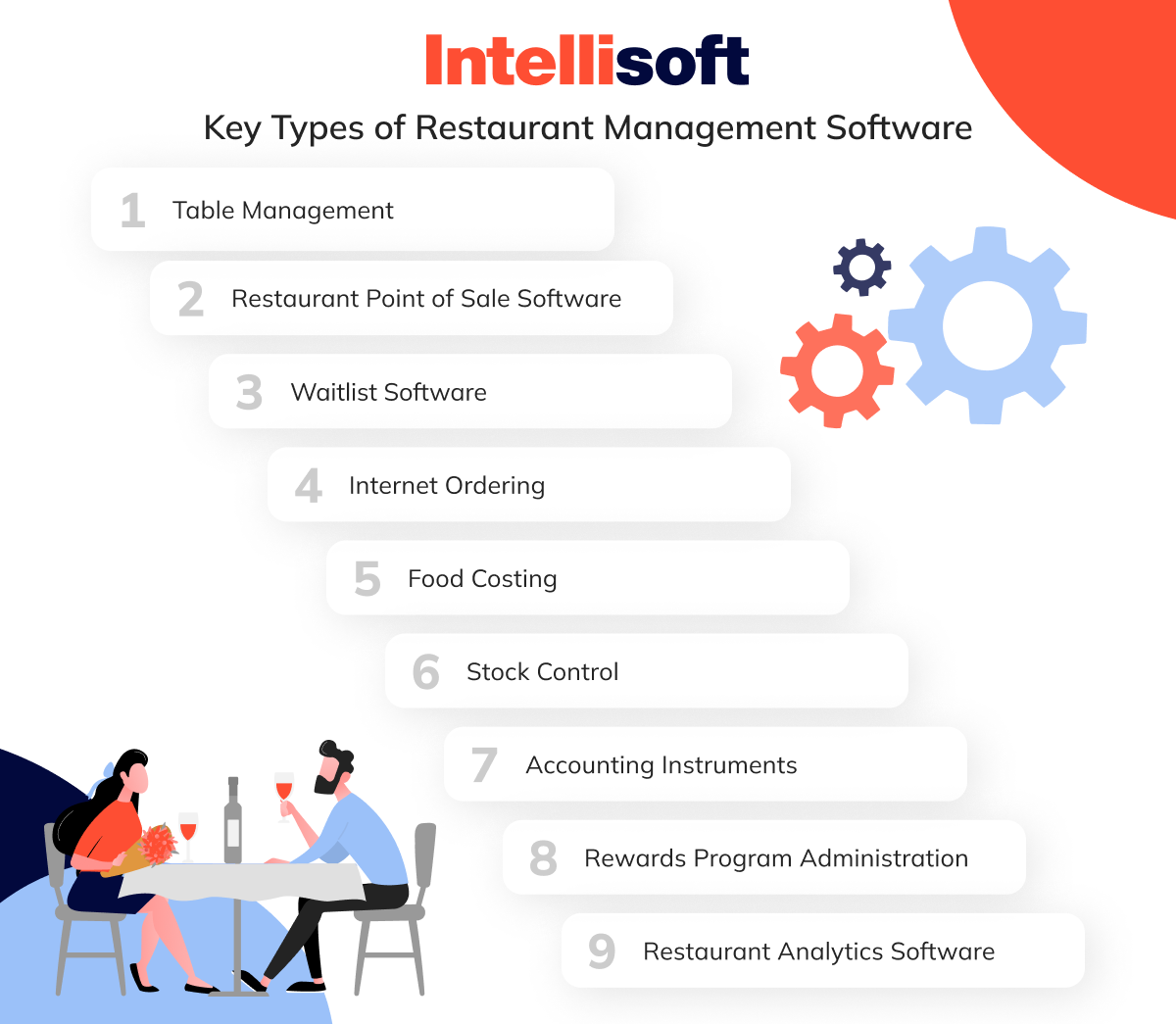
Table Management
Restaurant table management software simplifies managing reservations and table assignments for food establishments. Offering online and phone bookings, waitlist monitoring, and guest profiles that store information such as dietary needs and preferred seating, ensure a smoother dining experience for staff and customers. Some platforms also integrate with CRM systems, offering valuable data to help restaurants grow.
Popular options include OpenTable, Resy, and Eat App, each providing intuitive tools to optimize restaurant operations.
Restaurant Point of Sale Software
Restaurant-specific POS systems have become indispensable tools for streamlining everything from taking orders to processing payments, ensuring smooth day-to-day operations. These systems come packed with features designed to handle orders, tables, menus, and even restaurant inventory management software, making tasks much easier.
In addition, restaurant management POS software simplifies staff management and offers detailed reports and analytics, helping you keep the business running efficiently. Some systems even feature self-ordering kiosks, allowing customers to place their orders, speeding up service and creating a more personalized experience.
Popular choices in the market include Toast, Square, Revel, and Harbourtouch.
Waitlist Software
Waitlist management software has transformed how restaurants operate, simplifying waitlist handling, speeding up table turnover, and making the dining experience smoother for everyone. These systems go beyond just keeping track of reservations—they create digital waitlists, so customers can easily monitor their place in line while they wait for a table.
Additionally, these tools gather important guest details (for example, the size of the party and any special requests), and provide accurate, real-time estimates of wait times based on current table availability.
Platforms such as WaitWhile are excellent examples of how restaurants can significantly upgrade their service with intuitive, user-friendly solutions.
Internet Ordering
Online restaurant management software simplifies managing orders from different digital platforms, ensuring smooth operations whether customers order via a restaurant’s website, mobile app, or a third-party service.
This software eliminates much of the hassle with features such as order tracking, real-time updates for customers, feedback collection, and integration with the restaurant’s POS system. It even provides centralized management tools for businesses with multiple locations, making coordination easier.
Popular platforms such as ChowNow, DoorDash, and Upmenu keep restaurants connected and running efficiently in today’s digital landscape.
Food Costing
Food costing software has revolutionized the way the food and beverage industry operates. Whether running a small, cozy cafe or managing a large catering service, these tools help you keep track of the costs involved in preparing and serving meals and drinks.
Developed with owners, chefs, and managers in mind, restaurant menu management software simplifies tracking expenses, adjusting menu prices, and maximizing profits. Essential features often include monitoring ingredient prices, using restaurant recipe management software, analyzing menu performance, and even providing insights into allergens and nutritional information.
Many systems also assist with supplier management, delivery tracking, and price comparison to secure the best deals. Some popular solutions in the restaurant management software market include ChefTec, MarginEdge, and Parsley.
Stock Control
Restaurant inventory management software simplifies stock management by tracking food, drinks, and other supplies. It is crucial in minimizing waste, avoiding stockouts, and more effectively, controlling costs.
Notable restaurant stock management software features include real-time inventory tracking, vendor management tools, purchase order management, barcode scanning, stock rotation, low-stock alerts, and waste tracking. It also leverages historical data to predict future needs and refine ordering processes.
Well-known platforms in this space include Toast Inventory, and MarketMan.
Accounting Instruments
Restaurant business management software is designed to simplify financial management for business owners. It makes it easier to track expenses, monitor income, and comply with tax regulations. Its main features typically include account management, expense tracking, generating financial reports, processing payroll, and managing taxes, all in one place.
Many of these applications also integrate with point-of-sale (POS) systems, allowing users to monitor cash flow and credit card payments and even assist with budgeting and forecasting via restaurant financial management software.
Among the most popular options in this category are QuickBooks and ZipBooks, both well-known for their comprehensive features and ease of use.
Rewards Program Administration
Restaurant loyalty management software helps businesses strengthen customer relationships by offering tailored rewards, incentives, and engaging experiences. With member profiles, point-based systems, tiered loyalty structures, and customizable perks, these programs allow restaurants to monitor purchases, provide exclusive benefits, and even launch referral initiatives to expand their clientele.
Popular platforms such as Belly and FiveStars stand out for making loyalty easier to manage with intuitive and user-friendly tools.
Restaurant Analytics Software
These tools empower businesses to make more informed decisions, improving efficiency, customer satisfaction, and profitability. Gathering and analyzing data from various sources provides valuable insights into sales trends, financial forecasts, and reports. Some systems can connect with POS platforms, helping businesses monitor transactions and identify long-term customer behavior trends.
Well-known solutions in this space include CrunchTime and Fishbowl, both popular choices for their functionality.
How to Create Restaurant Software?
The success of all-in-1 restaurant management software development depends on many factors. Let’s answer the question “How to make a restaurant app” in eight steps:
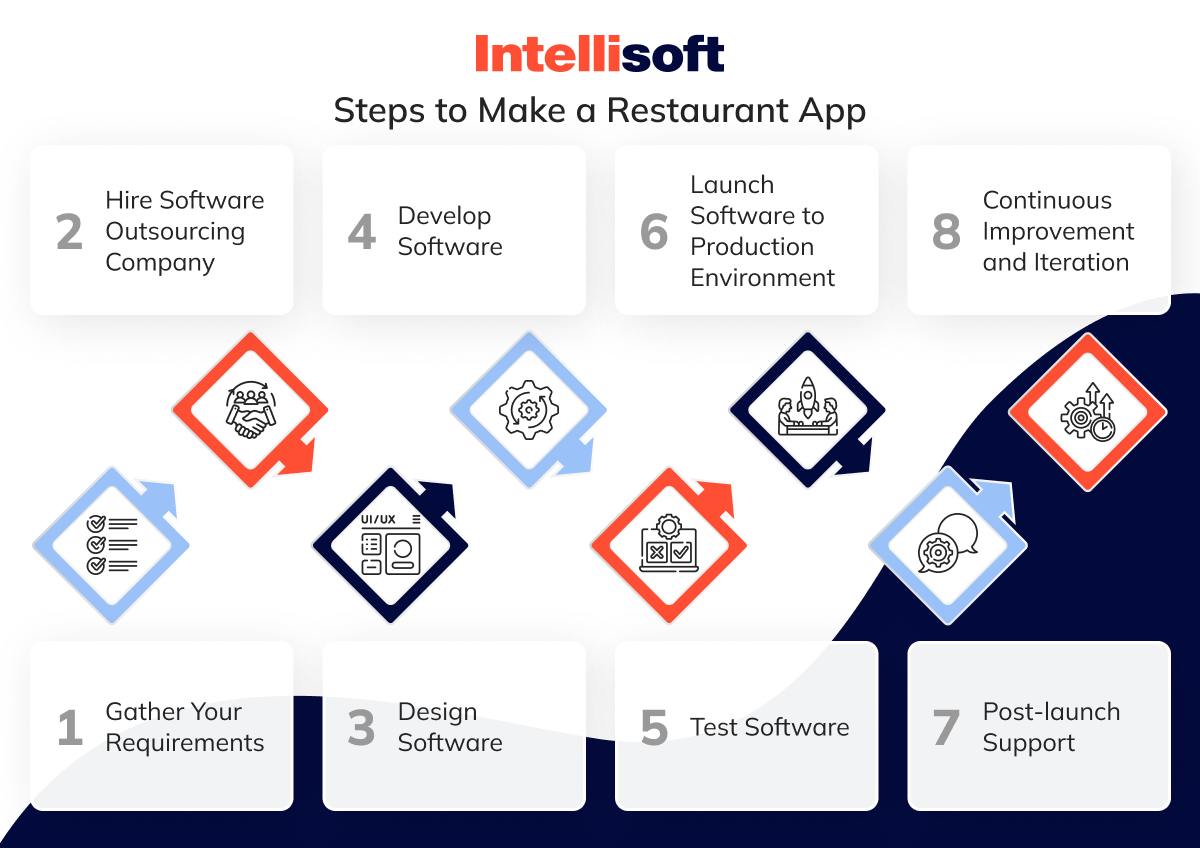
Gather Your Requirements
Requirements gathering is a crucial phase in RMS development that involves identifying, documenting, and analyzing stakeholders’ needs and expectations. This approach helps ensure the final product aligns with business goals and user needs, reducing the risk of costly changes later in development.
Stakeholder identification
In the context of RMS, stakeholders include restaurant owners, managers, staff (waiters, chefs, cashiers), customers, and third-party service providers such as payment processors or delivery services. It’s essential to understand each stakeholder’s role and how they interact with all in one restaurant management software to ensure their needs are met.
Understanding business goals
Understanding the restaurant’s business objectives is vital. These may include improving customer service, increasing sales, reducing waste, or optimizing staff management. Success is measured through specific criteria, such as reducing order processing time by 20% or increasing table turnover by 10%. These metrics help define clear goals for the RMS.
Eliciting requirements
Gathering requirements involves multiple methods. For example, you can conduct interviews or surveys to learn about stakeholder needs and pain points, such as staff challenges with current systems. Moreover, organizing workshops or focus groups for collaborative discussion and detailed insights is also beneficial.
Categorizing requirements
Requirements can be grouped into:
- Functional requirements. They include necessary features such as order management, inventory management software for restaurant, employee scheduling, and reporting.
- Non-functional requirements. They focus on performance characteristics such as scalability, security, and reliability. For example, the software must handle peak loads during busy hours without slowing down.
- User requirements. These cover user interface and experience needs, such as mobile access and integration with existing POS terminals.
- Regulatory requirements. They ensure compliance with health and safety regulations, data protection laws, and tax policies.
Documenting requirements
Once requirements are gathered, they should be documented in a structured way, typically using a Software Requirements Specification (SRS). It includes use cases and user stories to outline how users interact with the software. Wireframes or prototypes can also be developed to represent key functions and gather feedback early on visually.
Validating and prioritizing requirements
To ensure accuracy, the documented requirements must be validated with stakeholders to eliminate misunderstandings or gaps. Requirements should then be prioritized based on importance, feasibility, and business impact, helping the team focus on high-impact features first.
Managing requirements changes
A change control process should be established to manage new insights or evolving business needs that arise during development. Version control is also vital to track different iterations of the requirements document as updates are made.
Final sign-off
Obtaining formal approval from stakeholders on the gathered and documented requirements is essential before moving to the design and development phases. This ensures alignment and reduces the risk of misalignment later in the project.
Hire Software Outsourcing Company
Hiring a software outsourcing company to develop restaurant management software involves partnering with an external team of developers to design, build, and deliver the RMS for the restaurant or client. Rather than creating the software internally, the restaurant or business owner hires a specialized outsourcing firm to handle the development process.
Key advantages of outsourcing RMS development include gaining access to specialized skills, such as expertise in mobile applications, cloud based restaurant inventory management software, and user interface/user experience (UI/UX) design, along with valuable industry insights. Outsourcing is often more cost-efficient than hiring an in-house team, offering flexible pricing models. This approach allows restaurant owners to focus on core business activities while the outsourcing firm manages the technical side.
Additionally, these companies offer scalability, can quickly adapt to changes in project scope, and typically deliver faster results due to their streamlined processes. Outsourcing also helps minimize risks, ensures adherence to industry standards, and gives access to cutting-edge technologies and innovations.
Here are the steps to follow when hiring an outsourcing company for RMS development:
- Research potential partners. Look for firms with a proven history in RMS development or similar projects. Review their industry expertise, portfolios, client feedback, and case studies.
- Evaluate expertise and experience. Review the outsourcing team’s technical capabilities, ensuring they have experience with the technologies essential for RMS. Ask about previous similar projects and request references.
- Request proposals and quotes. Gather detailed proposals explaining the company’s project approach, including timelines, key milestones, and cost breakdowns. Compare these to make sure you’re getting good value for your investment.
- Conduct interviews and assess compatibility. Speak with key team members to evaluate their communication skills, cultural compatibility, and grasp of your business needs. Confirm their working style and project management practices align with your expectations.
- Define contract terms. Clearly outline the contract, covering the scope of work, deliverables, deadlines, payment terms, and intellectual property rights. Ensure clauses addressing confidentiality, data security, and post-launch support are included.
Design Software
Restaurant management software companies play an integral role, helping to create systems that are not only functional but also intuitive and visually appealing. Here’s how they contribute to the design process:
User experience design
The outsourcing team structures the software by organizing menus, screens, and features to align with the restaurant’s operational flow. UX designers develop wireframes to visually map out these elements, ensuring that buttons, forms, and critical functions are placed in a logical and user-friendly manner. They also chart user journeys—outlining the steps for common tasks such as placing orders or managing inventory via inventory management restaurant software. By doing so, they ensure a smooth and intuitive experience. Usability testing is done throughout, allowing for early-stage feedback and refinements before diving into full development.
User interface design
UI designers focus on the visual aspects of the food and beverage management software for restaurant, such as colors, typography, and icons, creating an interface that’s both aesthetically pleasing and in line with the restaurant’s branding. Interactive prototypes are often used, giving stakeholders a hands-on preview of how the software will function. This approach ensures that feedback can be gathered and applied before moving forward. Consistency across all screens is key, ensuring the software is easy to navigate while maintaining the restaurant’s brand identity.
Responsive design
To ensure the software works seamlessly across different devices, it is designed to adapt to various screen sizes, from desktop POS terminals to mobile devices. This flexibility allows restaurant staff to manage tasks from any device, ensuring an optimal experience regardless of where or how it’s used.
Collaborative design & feedback
The design process is iterative, with outsourcing teams regularly presenting progress to the client and refining the product based on feedback. Regular stakeholder reviews ensure that the design is aligned with the business’s goals and meets user expectations, fostering a collaborative environment and ensuring the final product reflects the restaurant’s vision.
Prototyping & user testing
High-fidelity prototypes with detailed visuals and functional interactions are created to give stakeholders a near-complete look at the restaurant management software open source. These prototypes are tested by restaurant staff, whose feedback helps fine-tune the design before it’s passed on for development, ensuring it’s optimized for real-world use.
Design handoff to development
Once the design is finalized, detailed specifications—such as color schemes, typography, and spacing—are handed over to the development team. Tools such as Figma or Adobe XD facilitate this handoff, ensuring developers have clear and precise guidelines to follow during the implementation phase.
Ongoing design support
Even after the design is handed off, the outsourcing company provides support during development, making adjustments as needed. They may also help with post-launch updates or redesigns, ensuring that the software restaurant management evolves in line with the restaurant’s changing needs.
Following the software launch, the outsourcing company may continue to assist with updates or redesigns, ensuring the system adapts to the restaurant’s evolving needs.
Develop Software
When a restaurant hires a restaurant management software development company to develop its RMS, the outsourced team is crucial in turning ideas into a reliable and scalable product. Here’s a breakdown of how the process typically unfolds:
- Project planning and kickoff. It all begins with a roadmap. The outsourcing team creates a detailed project plan covering timelines, key milestones, resource allocation, and risk management strategies. Next, they assemble a skilled team of developers, QA testers, project managers, and other professionals necessary for the project. Once the team is set, they establish the development environment, complete with tools, frameworks, version control (such as Git), and continuous integration/continuous deployment (CI/CD) pipelines to ensure things run smoothly from the start.
- Backend development. Backend development starts with designing a database to manage orders, inventory, customer info, and employee data via HR management software for restaurant employees. The team chooses SQL or NoSQL and optimizes it for performance. They then create APIs (RESTful or GraphQL) to connect the frontend with the backend for orders, payments, and reservations. Core RMS features such as order management, table management software restaurant, and schedules are developed, with third-party integrations added if needed for smooth data flow.
- Frontend development. On the frontend side, the team translates the UI designs into code using technologies such as HTML, CSS, and JavaScript, often with React, Angular, or Vue.js frameworks. The aim is to create a smooth, intuitive user interface that works well across different devices. The frontend is then connected with backend APIs, enabling real-time features such as order status updates, restaurant inventory management software, and user logins. To ensure an excellent experience on any device, the UI is designed to be fully responsive, adjusting effortlessly to desktops, tablets, and smartphones.
Related articles:
- How to Build Enterprise Resource Planning (ERP) Software: a Complete Guide
- White Label Software Development Guide
- How To Build A Software From Scratch That Meets Your Goals?
- Restaurant Billing Software: How to Develop
- Software Regulatory Compliance: Navigating Compliance Management
Test Software
Before your web based restaurant management software is ready to go live, it must pass one final, crucial hurdle; quality assurance and testing. This essential phase ensures that every feature runs smoothly and can withstand the challenges of real-world use. Here’s how the outsourcing team makes sure your software is thoroughly tested and prepared for action:
Automated testing
The QA team relies on automated tests such as unit, integration, and end-to-end testing to ensure the software behaves as expected. These tests help identify bugs early, speeding up the restaurant management software development process and making everything run more smoothly.
Manual testing
Manual testing takes over for user interface, usability, and overall user experience. This hands-on method catches issues that automated tests might miss, ensuring the product is intuitive and easy to use.
Performance testing
The team conducts performance tests to ensure the system can handle heavy traffic, such as during a busy restaurant rush with high transaction volumes and large data sets. These tests ensure that the restaurant inventory management and purchasing software runs efficiently under pressure.
Security testing
Security testing is crucial to protect customer data. It includes identifying vulnerabilities (such as SQL injection and cross-site scripting (XSS)) and ensuring effective encryption. The focus is on keeping sensitive information safe.
Launch Software to Production Environment
After months of hard work, testing, and refining, your restaurant’s management software is finally ready to go live! But before you can start enjoying the benefits of streamlined operations, there’s one last critical step; deployment. Here’s a quick look at what happens during the rollout and how the outsourcing team ensures everything goes off without a hitch.
- Deployment strategy. The outsourcing team creates a deployment plan for your restaurant’s unique needs. Whether you opt for a cloud based restaurant management software solution such as AWS or Azure or stick with an on-premises setup, they’ll ensure everything is optimized for peak performance.
- CI/CD pipeline. If your system uses a Continuous Integration/Continuous Deployment (CI/CD) pipeline, the software is rolled out smoothly across both staging and production environments. This approach means fewer manual processes and faster and more reliable updates.
- Data migration. Switching from an older system? Don’t worry. The company transfers all your historical data (for example, customer information and previous orders), so nothing is lost, and the shift feels seamless.
- Post-launch monitoring. The team stays on top of things even after the software goes live. They continuously monitor performance, check server health, and address potential issues, ensuring your system operates smoothly from day one.
Post-launch Support
Launching new restaurant facilities management software is just the start. Ongoing support and maintenance are crucial to ensure your RMS keeps operating smoothly. Here’s what that entails:
Rapid bug fixes
No system is flawless, but with a dedicated support team, any bugs or glitches that appear post-launch are resolved swiftly. Expect prompt patches and fixes before any issues affect your operations.
Smooth software updates
As your restaurant evolves, so should your software. Regular updates from the support team ensure it stays compatible with new technologies and compliant with changing regulations.
Performance enhancements
As your business grows, your digital solution must keep pace. The support team continuously optimizes performance, ensuring everything runs smoothly, even as your user base expands.
Training and documentation
Proper training is essential to getting the most out of your RMS. The support team provides thorough training and clear documentation, giving your staff the confidence to use the system efficiently.
Continuous Improvement and Iteration
The outsourcing company is essential in ensuring the restaurant management software (RMS) remains adaptable and scalable. By incorporating feedback directly from users, they ensure the quick service restaurant management software evolves to meet the changing demands of the restaurant industry. As the business grows, the company refines the RMS, enabling it to seamlessly accommodate more users, transactions, or even additional locations. This ongoing enhancement process ensures the system stays aligned with the restaurant’s dynamic growth and operational needs.
As David Chang, Chef and Founder of Momofuku, said, “The right restaurant management software allows us to turn tables faster, reduce waste, and focus on the dining experience, not the back-end processes.”
Key Features for Restaurant Management Software
Modern restaurant management software should simplify daily operations, enhance the customer experience, and enable smarter decision-making for business owners. Here’s a closer look at the key features that make RMS a real game-changer:
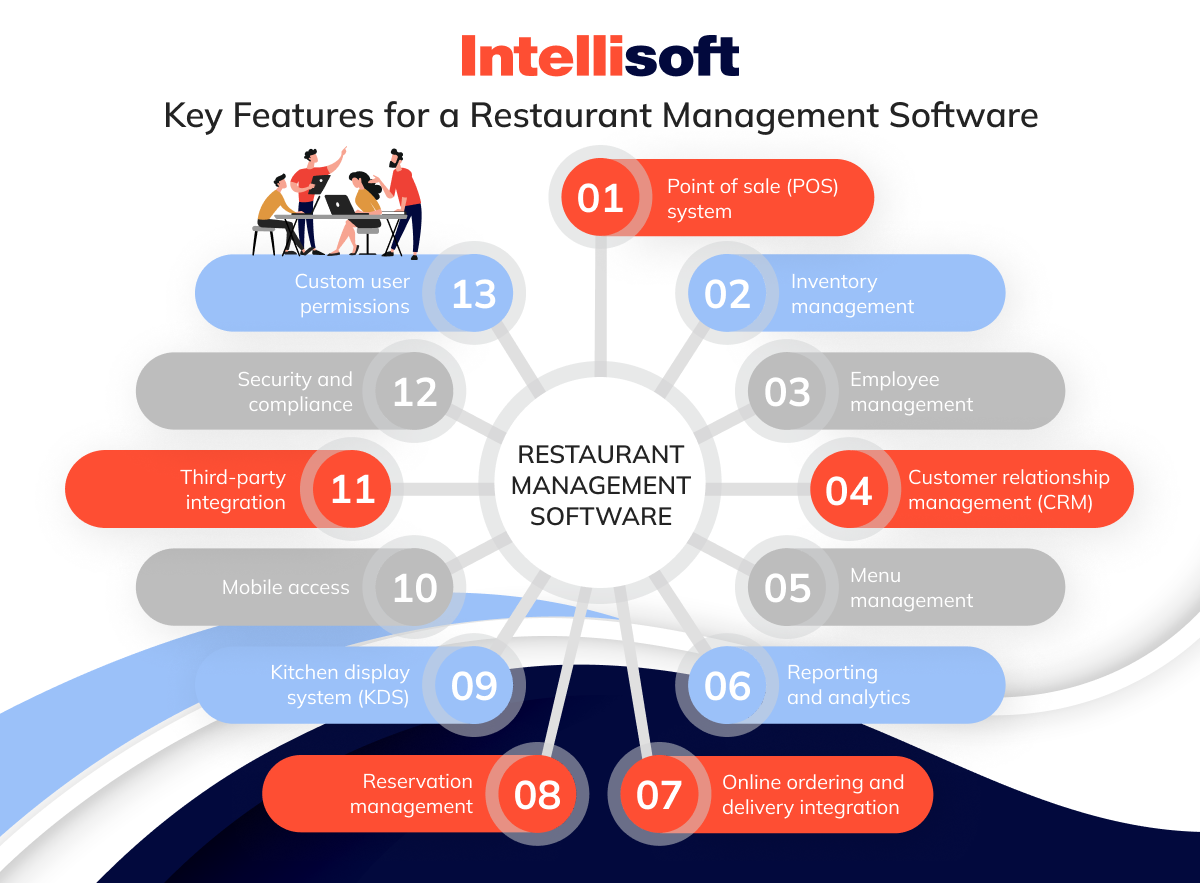
- Point of sale (POS) system. Smoothly handle orders for dine-in, takeout, and delivery, while efficiently managing payments, splitting bills, and organizing tables.
- Inventory management. Monitor stock levels, manage supplier relationships, and minimize waste to boost efficiency and cut costs.
- Employee management. To ensure smooth operation, streamline staff scheduling, integrate payroll, and track performance via restaurant staff management software.
- Customer relationship management (CRM). Create loyalty programs, maintain a robust customer database, and manage feedback and reviews to keep customers returning.
- Menu management. Easily update and customize your menus, sync them with online platforms, and handle daily specials or promotions effortlessly.
- Reporting and analytics. To inform smarter business decisions, generate in-depth sales, inventory, and customer behavior reports.
- Online ordering and delivery integration. Offer a seamless online ordering experience, manage delivery logistics, and provide real-time tracking for customer orders.
- Reservation management. Let customers book online, manage waitlists, and easily handle large group reservations.
- Kitchen display system (KDS). Restaurant kitchen management software can display live orders in the kitchen, prioritize them based on prep time, and enhance communication between staff and the front of the house.
- Mobile access. Equip your team to take orders and process payments on mobile devices while you manage operations via restaurant management software for Android or iOS.
- Third-party integration. Connect with accounting tools, marketing platforms, and suppliers via the restaurant vendor management software to streamline and automate various business processes.
- Security and compliance. Protect customer data and ensure local health, safety, and tax regulations compliance.
- Custom user permissions. Assign different access levels to your staff and monitor system activity to maintain security across the board.
Tech Stack
When developing hotel management software offline with restaurant POS system, choosing the right tech stack is critical. It guarantees that your software will be scalable, secure, user-friendly, and efficient. A well-rounded tech stack includes everything from front-end and back-end frameworks to the database and tools that speed up the development process. To set you on the right path, here’s a suggested tech stack that covers all the essentials for creating high-quality RMS.

Frontend Development
Here are 4 key tools to consider:
- Frameworks and libraries. If you’re building dynamic user interfaces, both React and Vue.js are great options. React is a flexible and powerful JavaScript library perfect for single-page applications. It has a strong community and a component-based structure. On the other hand, Vue.js is lightweight, beginner-friendly, and easy to integrate, making it ideal for interactive user interfaces with a gentler learning curve.
- HTML/CSS. HTML5 is the backbone of all web content, providing structure to your web pages and applications. CSS3 handles the styling, giving life to your designs. SASS and LESS preprocessors offer advanced features that make styling more efficient and streamlined for those looking to take their CSS skills to the next level.
- Responsive design. These frontend frameworks are handy to ensure your designs look great on all devices. Tailwind CSS gives you a utility-first approach for custom designs, while Bootstrap offers pre-made components to streamline your work.
- Mobile development. Want your restaurant management software Android to work on iOS too? React Native (using JavaScript) and Flutter (using Dart) are your best bets. These cross-platform tools let you build mobile apps from a single codebase, saving you time and effort.
Backend Development
As for backend development of the restaurant management software, here are some factors to think about:
Programming languages
Node.js with Express.js is a fast, non-blocking JavaScript runtime perfect for scalable backend development, with Express.js simplifying the process. Python, known for its readability, offers two popular frameworks: Django, a full-featured option, and Flask, which provides flexibility for custom builds. Java with Spring Boot is a robust choice for restaurant enterprise management software, offering security, scalability, and strong support for large projects.
API development
RESTful APIs are a tried-and-true method for frontend-backend communication. Still, if you’re looking for more control, GraphQL allows clients to request the data they need, making it a flexible alternative.
Real-time communication
Do you need live order tracking or an interactive kitchen display? WebSockets or Socket.io (for Node.js) enables fast, two-way communication between the server and the client, ensuring everything happens instantly.
Database
Choosing the right database is critical to ensuring your application runs smoothly and scales as needed. With so many options, how do you find the one that fits your project? It all depends on your needs:
- Relational databases. PostgreSQL stands out as a robust open-source option. It is well-regarded for its reliability and ability to handle complex queries and advanced features, making it a solid choice for more demanding applications. Similarly, MySQL is another widely trusted open-source database, appreciated for its user-friendly nature and seamless integration with various platforms, so developers often rely on it.
- NoSQL databases (optional). If your app needs to handle unstructured data (such as customer interactions, logs, or real-time analytics), MongoDB is a flexible NoSQL solution built to manage these dynamic data sets easily.
- In-memory databases. When speed is critical, Redis is an excellent choice. This in-memory key-value store excels in caching, session management, and real-time analytics, delivering rapid data access to ensure your application runs efficiently.
Authentication and Authorization
When developing a web or mobile application, securing user authentication is essential to safeguarding sensitive information and preserving user trust. Several solutions are available, each offering distinct advantages depending on the use case. Let’s explore some of the most widely used tools and techniques to authenticate and authorize users.
OAuth2 vs. JWT
OAuth2 and JWT are the most widely used solutions for securing user access, but they cater to different scenarios. OAuth2 is exceptional for generating access tokens, which give users safe, temporary permissions to interact with your system. In contrast, JSON Web Tokens (JWT) are perfect for stateless authentication, streamlining the process by delivering encrypted tokens without storing session data server-side.
Firebase authentication
Firebase Authentication, meanwhile, stands out as a convenient and trustworthy option for developers looking to integrate user sign-in features quickly. With support for traditional email/password logins and social sign-ins (for example, Google and Facebook), Firebase simplifies securing user accounts. This approach lets you focus on developing your app’s core features while ensuring robust user authentication.
Cloud Services and Hosting
Understanding containerization can also bring much-needed flexibility to your system, allowing it to grow more efficiently. Let’s look at the major cloud providers and the tools that can significantly impact your project’s success.
- Cloud providers. As the industry leader, AWS offers a wide range of services, including EC2 for computing power, RDS for database management, S3 for scalable storage, and Lambda for serverless applications designed to help you build and scale effortlessly. Google Cloud Platform (GCP) similarly provides App Engine for hosting, Cloud SQL for database management, and Firebase for mobile and web apps, making it a strong option for developers seeking a seamless, integrated experience. Meanwhile, Microsoft Azure, widely favored in a multi-unit restaurant chain management software system, offers a robust set of tools comparable to AWS and GCP.
- Containerization and orchestration. Docker enables you to package applications into containers, ensuring they run consistently across various environments without compatibility issues. When scaling these containerized applications, Kubernetes steps in as the preferred orchestration tool, simplifying the management of multiple instances and ensuring smooth operations as your system grows.
DevOps and CI/CD
How do you keep your code running smoothly, track changes effortlessly, and manage your infrastructure? The answer lies in using the right tools for modern development: CI/CD platforms, version control systems, and infrastructure-as-code (IaC) solutions.
CI/CD tools
Platforms such as Jenkins, GitLab CI, and CircleCI simplify your development workflow by automating integration and deployment tasks. These tools ensure your code is tested and deployed automatically, reducing the chance of errors and speeding up the delivery process.
Version control
Git is essential for collaborative development. Platforms such as GitHub and GitLab offer much more than version control—they provide issue tracking, code reviews, and seamless integration with CI/CD pipelines, keeping your project organized and efficient.
Infrastructure as code (IaC)
Terraform and AWS CloudFormation have revolutionized infrastructure management. These platforms let you define and manage your cloud infrastructure through code, making it easy to set up, configure, and scale your environments without manual effort.
Analytics and Reporting
With the right tools, you can gather valuable insights that will allow you to optimize your system and make well-informed decisions. Let’s explore two powerful options that can elevate your reporting and analytics.
Google Analytics or Mixpanel. These platforms track user interactions, usage trends, and other key metrics that can help you fine-tune your RMS for better performance.
Custom reporting with Python (Pandas, Matplotlib). Python libraries (such as Pandas) can handle data manipulation for more tailored reports, while Matplotlib brings your data to life with visualizations.
Security
Security should always be the top priority when protecting sensitive data and maintaining reliable user access. This section will explore two essential methods for securing your platform: encryption and threat detection.
SSL/TLS for data encryption
Implementing SSL/TLS protocols ensures that all communication between your client and server is encrypted. This method guarantees that any data exchanged remains secure and private.
Firewall and intrusion detection
Use cloud-based security tools or traditional firewalls to safeguard your application from malicious activity. These can help block potential threats and detect suspicious behavior before it compromises your system.
Testing
To ensure your app is equipped to perform flawlessly in any environment, several key testing methods should be applied:
- Automated testing. Using JUnit for Java, PyTest for Python, or Jest for JavaScript, you can automate unit tests to verify that individual components behave as they should.
- End-to-end testing. Tools such as Selenium or Cypress are ideal for automating end-to-end tests and simulating real user interactions to confirm that the entire system operates smoothly from start to finish.
- Performance testing. Apache JMeter or Gatling is widely used for load testing. These tools allow you to measure your application’s performance under heavy traffic, ensuring it can handle peak loads without slowing down or crashing.
Third-Party Integrations
Whether handling transactions or keeping your users informed, selecting the right services can make all the difference. Let’s break down the key players that will help you streamline these critical operations.
Payment gateways
Popular choices for payment processing include Stripe, PayPal, and Square, each offering reliable solutions for secure and efficient transactions. Depending on your needs, Stripe might be perfect for its flexibility, while PayPal provides a wide global reach, and Square stands out for its ease of use with small businesses.
Email/SMS Services
Regarding notifications, Twilio and SendGrid offer top-notch services for sending real-time updates via email or SMS. Twilio excels at sending quick, personalized messages, while SendGrid is known for easily handling large-scale email campaigns. Both services ensure that your customers and staff stay informed without a hitch.
How Much Does Custom Restaurant Management Software Cost?
The cost of custom restaurant management software can vary significantly based on several factors, such as software complexity, included features, development team location, and the timeline for development. Below is a detailed breakdown of the factors influencing the cost and general cost estimates.
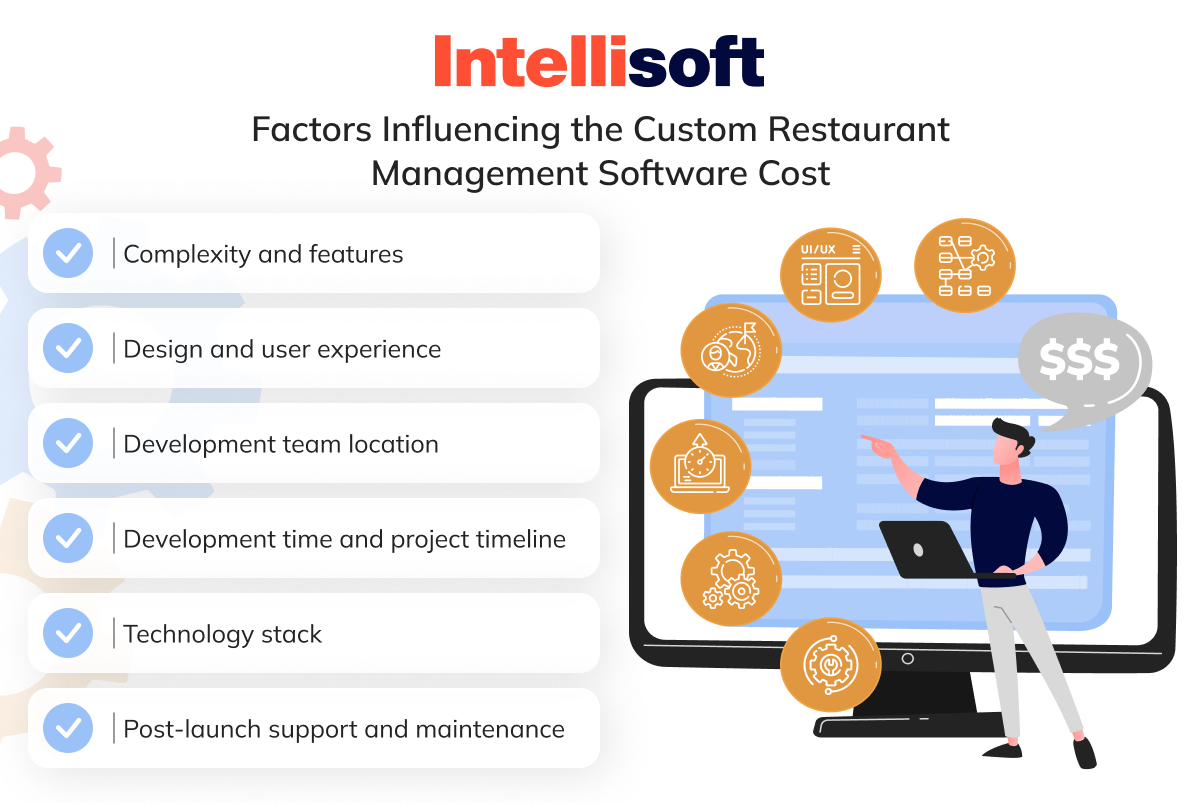
- Complexity and features. A simple RMS with order management, payment processing, and inventory management software restaurant will have a lower cost. Adding complex features such as CRM integration, detailed analytics, multi-location management, mobile apps, and third-party integrations (e.g., delivery services) will increase the overall cost.
- Design and user experience. Fully customized UI/UX designs tailored to your brand are more expensive than standard templates. Ensuring compatibility across devices (tablets, mobile phones) increases development time and costs.
- Development team location. Hiring developers from North America or Western Europe tends to be more expensive due to higher labor costs. Outsourcing to countries such as India, Eastern Europe, or Southeast Asia can lower costs.
- Development time and project timeline. Shorter timelines may require a larger team working more hours, increasing costs. Longer timelines might spread the cost over time but could involve additional ongoing support.
- Technology stack. The choice of programming languages, frameworks, and third-party services impacts the cost. For instance, cloud services such as AWS or Azure could incur ongoing operational expenses.
- Post-launch support and maintenance. Maintenance, updates, and support after launch will add to the cost. It could be billed monthly or on an as-needed basis.
Cost Reduction Strategies
Here are three ways to cut restaurant management software development costs:
- MVP approach. First, build a simplified software version that includes only the core features. This method helps keep initial development costs down while allowing you to gather important user feedback before investing in more complex features.
- Leveraging open-source tools. You can significantly lower licensing fees and overall project expenses by using open-source software for specific components, such as databases or point-of-sale systems.
- Phased development strategy. Think about dividing the development process into several phases. Begin by implementing the most essential features and then gradually introduce more advanced functionalities. This phased approach makes managing the budget easier and offers the flexibility to adjust as needs evolve.
The cost of a custom restaurant management software solution can vary greatly depending on your specific needs and strategies. A basic solution might range between $20,000 and $50,000, while more intricate systems with advanced features can exceed $100,000. Clearly defining your requirements, working closely with your development team, and planning for up-front and long-term expenses are vital to ensuring the software meets your budget and operational goals.
Conclusion
Robust and tailored restaurant management software is crucial for streamlining operations, enhancing customer experiences, and driving business growth in HoReCa industry. Developing such a comprehensive system requires technical expertise and a deep understanding of the restaurant industry’s unique challenges and needs.
At IntelliSoft, we specialize in creating custom restaurant management software solutions perfectly aligned with your business goals. You will gain access to a team of dedicated professionals committed to delivering excellence. We understand the intricacies of restaurant management and leverage our expertise to create software that empowers your business to thrive.
Contact us today to transform your restaurant operations with a state-of-the-art management system!





